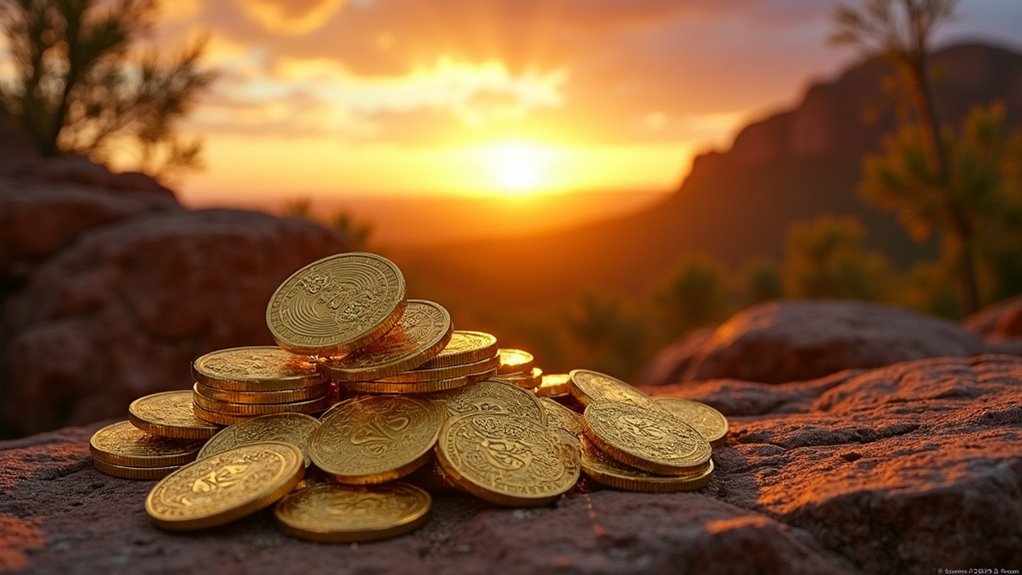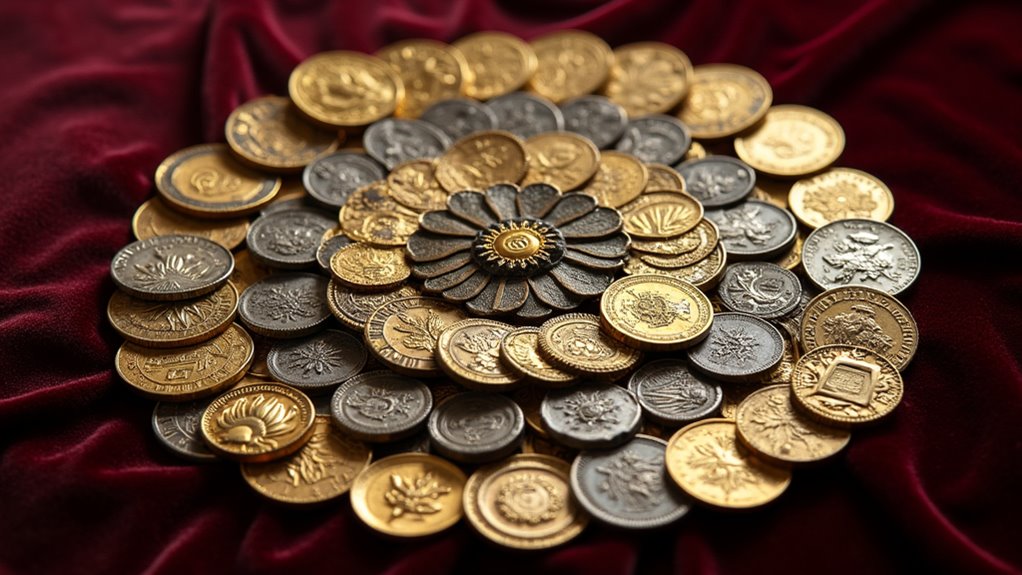Fafnir, a dwarf turned dragon in Norse mythology, embodies the curse of gold that fuels greed and ruin. Once tasked with guarding a treasure, he murders his father for the hoard, cursed by the ring Andvaranaut, and transforms into a monstrous serpent. Slain by hero Sigurd, Fafnir’s tale warns of wealth’s dangers. At Karat.au, we’re passionate about gold’s allure, rooted in Australia’s mining heritage. Stick around to uncover deeper insights!

A legend as old as the Norse winds, the tale of Fafnir the Dragon and the cursed gold hoard reverberates with a stark warning about greed’s destructive power. In the ancient sagas of Scandinavia, Fafnir begins as a dwarf, son of the king Hreidmar, tasked with guarding a treasure of gold and jewels. His family, gifted with sorcery, could shape-shift, yet even such power couldn’t shield them from calamity.
When the god Loki kills Fafnir’s brother Otr—disguised as an otter—the gods are forced to pay weregild, a compensation in gold. Loki seizes a hoard from the dwarf Andvari, including the cursed ring Andvaranaut, which promises ruin to its possessor. This gold, used to cover Otr’s skin, becomes the seed of tragedy.
Hreidmar’s refusal to share this bounty ignites Fafnir’s avarice. Driven by an insatiable hunger, he murders his father and claims the entire hoard, denying his brother Regin a share. Fleeing to Gnita-Heath, Fafnir’s greed and the curse transform him into a fearsome dragon—or serpent, in some tellings. There, in a desolate lair, he guards the glittering pile, his breath turning poisonous, blighting the land.
Even as a beast, Fafnir retains a sharp mind and the ability to speak, a chilling reminder of the dwarf he once was. Sometimes depicted wearing the Helm of Awe, his presence is both majestic and terrifying, a symbol of wealth’s corrupting might. Gold has historically served as a safe haven asset, especially for those seeking stability in turbulent times. In modern economies, gold remains a key hedge against currency risk, protecting investors from inflation and market volatility. This enduring characteristic reinforces gold’s role as a store of value in uncertain economic climates.
Enter Sigurd, a hero fostered by Regin, who seeks both vengeance and treasure. Regin forges the mighty sword Gram, capable of cleaving an anvil, and guides Sigurd to ambush the dragon. Digging a pit along Fafnir’s path to water, Sigurd hides and strikes the beast’s vulnerable underbelly as it crawls overhead. Mortally wounded, Fafnir warns Sigurd of the curse before dying.
Yet the gold’s taint lingers—Regin plots betrayal, only to be thwarted when Sigurd, tasting the dragon’s blood, gains the wisdom of birds who reveal the scheme. Sigurd slays Regin and claims the hoard, a bitter victory steeped in loss. This narrative serves as a cautionary tale about the dangers of gold investment, illustrating how wealth can lead to ruin if not handled wisely.
This tale, etched in the Völsunga Saga and Poetic Edda, echoes across time, inspiring figures like Tolkien’s Smaug. Fafnir embodies the peril of obsession, a lesson as relevant today as it was in Viking halls. Moreover, the enduring importance of gold reserves in today’s economy highlights the persistent allure and potential dangers of wealth.
At Karat.au, we’re captivated by gold’s timeless allure, yet mindful of its risks. Just as Fafnir’s story warns of avarice, we endeavor to demystify gold ownership for Australians, blending our nation’s mining heritage with transparent insight. We’re passionate about guiding both newcomers and experts through market intricacies, ensuring clarity without offering financial advice.
Let’s honour gold’s legacy—its beauty and its burdens—with wisdom, not greed. (Oops, almost typed ‘greed’ twice there!)
Frequently Asked Questions
What Inspired the Creation of Fafnir’S Myth?
The inspiration behind certain ancient myths often stems from deep cultural values and human struggles, reflecting timeless lessons on morality.
These tales, rooted in Germanic folklore from the Migration Period (c. 0-400 CE), evolved through oral traditions during the Viking Age. They draw from shared archetypes of greed and betrayal, weaving cautionary narratives.
Karat.au celebrates such heritage, connecting past wisdom to the enduring allure of precious treasures.
How Does Fafnir Compare to Other Dragons?
Comparing dragons across cultures reveals striking diversity in form and symbolism. Some are serpentine, mystical beings tied to water and wisdom, while others are fierce, winged beasts embodying chaos or destruction.
Physical traits vary—some boast impenetrable scales, others mystical flight. Their roles differ too, from guardians of treasure to cosmic forces.
This rich tapestry of lore showcases how human imagination shapes these legendary creatures, reflecting deep cultural values.
Are There Modern Adaptations of Fafnir’S Story?
Modern adaptations of classic tales captivate audiences across various media. These stories, reshaped for today’s world, appear in literature, film, games, and art, blending ancient themes with contemporary flair.
From epic operas to thrilling video games, the essence of timeless narratives endures, inspiring new generations.
Karat.au revels in how such legacies mirror gold’s enduring value—timeless yet ever-relevant. These reimaginings prove that old lore still shines bright, dont they?
What Cultural Impact Does Fafnir Have Today?
Fafnir’s cultural impact today resonates through various mediums, enchanting global audiences. His story inspires modern fantasy literature, video games, and anime, embodying timeless themes of greed and transformation.
From Tolkien’s dragons to epic boss battles in gaming, his influence endures. Artistic expressions, like music and even a star named in his honour, reflect his legacy.
Fafnir remains a powerful symbol of human flaws, bridging ancient myth to contemporary storytelling.
Is Fafnir Linked to Other Mythologies?
Exploring mythological connections, one finds that serpent and dragon tales weave through various ancient cultures, sharing striking similarities.
These narratives often stem from Proto-Indo-European roots, linking stories across Europe and beyond.
Themes of heroes battling monstrous serpents echo in diverse traditions, revealing a shared human fascination with such archetypes.
At Karat.au, we’re captivated by these timeless tales, reflecting on how they mirror gold’s enduring, sometimes perilous, allure in history.















